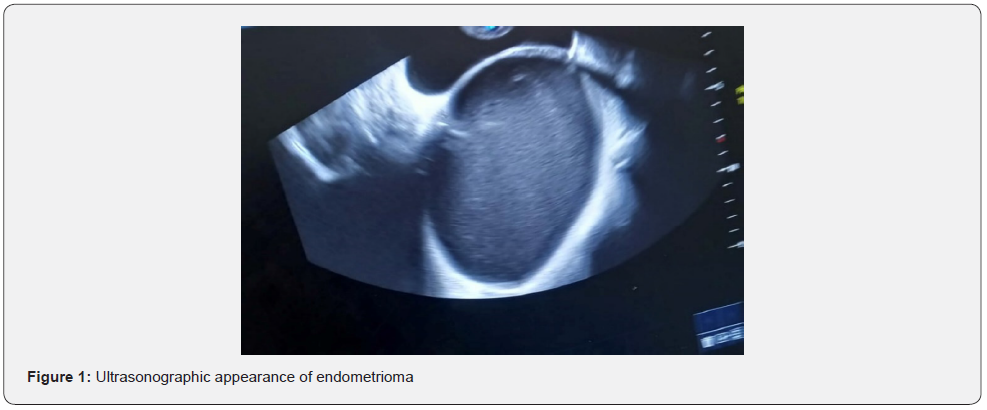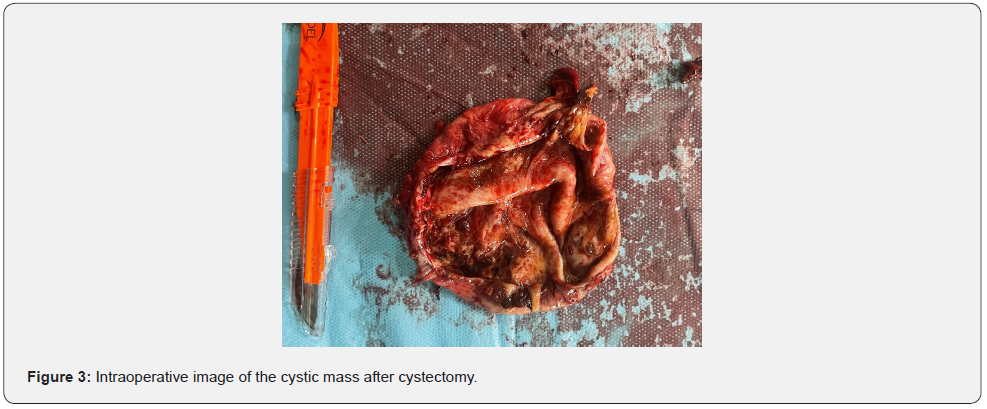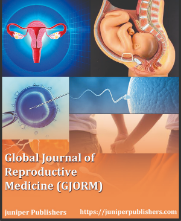Torsion of an Ovarian Endometrioma: About an Uncommon Case Report
GLOBAL JOURNAL OF REPRODUCTIVE MEDICINE-JUNIPER PUBLISHERS
Endometrioma, when its size is ≥ 5 cm, can be complicated by a torsion of the ovary. In this case it is a diagnostic and therapeutic emergency with respect to the many complications of ovarian torsion including necrosis.
We report a case of endometrioma diagnosed by a torsion of the ovary. The context clinic was dominated by acute pelvic pain; the ultrasound showed a huge left cystic ovary, and the laparotomy revealed a torsion of the left adnexa. A detorsion and cystectomy was performed and the confirmation of the endometrioma was provided by the histology of the surgical specimen.
The difficulty lies in the diagnostic and therapeutic choice to preserve or not the ovary. The indications are therefore discussed on a case-by-case basis and depend on many parameters, the most important of which is the intraoperative viability of the ovary after its detorsion.
Introduction
Torsion of endometriomas is uncommon due to associated pelvic adhesions [1]. Nevertheless, it constitutes the fifth gynecological emergency [2]. We report an interesting case of a 35-year-old patient; who presented to our department for acute pelvic pain; To our knowledge, our patient had no particular medical or surgical history; gynecological examination and the ultrasound was in favor of a torsion of a huge ovarian cyst; the treatment was surgical with the realization of a conservative treatment: detorsion and cystectomy. The histological examination came back in favor of an endometrioma.
Case Report
A 35-year-old woman presented to our emergency department complaining of acute pelvic pain associated with vomiting for the last five hours which responded poorly to the analgesics .no vaginal bleeding or discharge was present. She had no relevant medical or surgical history G3P3.
In our physical examination, the patient was conscious, there was no notion of digestive transit disorders, nor micturition disorders. The abdomen was tender to palpation. The gynecological examination was unremarkable. The clinical picture was mainly dominated by acute pelvic pain in a patient with no particular history.
Given the urgency, we immediately performed an ultrasound coupled with Doppler of the abdomen objectifying a left ovarian cyst measuring 12 cm in diameter (Figure 1). However, torsion was not excluded. There was neither leukocytosis nor raised CRP. BHCG was negative.
Laparotomy was performed. Intraoperative findings revealed a large cystic arising from the left ovary; it was around 12 cm in size. There was torsion of this cyst on its pedicle by two turns (Figure 2), the right ovary was normal. the detorsion and cystectomy was performed (Figure 3). Thereafter. The histology report described an endometrioma with extensive hemorrhagic.
The postoperative period was uneventful, and the patient was discharged from the hospital 3 days after surgery.



Discussion
Endometrioma is one of the most frequent localizations of endometriosis. According to the theory of Hughesdon and Broosens, the endometriosis cyst is formed either from an endometrial implant in the ovarian fossa, or from an inversion and invagination of the ovarian cortex. This cyst can grow and reach a size of 5 cm at most [2] rarely exceeds 10–15 cm in diameter [1].
Theoretically, the most common cysts associated with torsion are cystic teratomas and cystadenomas, accounting for 60% and 30% of all cases, respectively [4]. Ovarian endometrioma are less likely to twist because of accompanying adhesions [1].
The clinical diagnosis of ovarian torsion is difficult to establish. Abdominal pain is the ubiquitous symptom in all cases of ovarian torsion [3]. The onset of this pain is often sudden and localized [4]. But it can have extremely different characteristics [3,5]. Indeed, pain can occur intermittently before the torsion, which corresponds to phenomena of torsion detorsion of the ovary [4,5]. The clinical picture presented by our patient was essentially dominated by acute pelvic pain.
Torsion of an endometrioma is a diagnostic and therapeutic emergency. Indeed, torsion of the ovarian pedicle is responsible for ischemia and then edema of the ovary which, untreated, progresses to ovarian necrosis, thrombophlebitis, hemorrhage and, in extreme cases, peritonitis [6].
The typical appearance of torsion in ultrasound is manifested by unilateral ovarian enlargement with edema and peripheral arrangement of the follicles [7]. The presence of a spiral pattern has been shown to increase the sensitivity of the examination [8]. The absent arterial flow on Doppler is associated with 100% of cases of torsion [9]. However, this sign has a low negative predictive value since the complete absence of flow is only visible in the late phase. MRI has shown a higher sensitivity for detecting a pelvic mass than ultrasonography [10].
In our case, the ultrasound showed an ovarian cyst without objectifying the intra cystic vascular changes. The rapidity of the diagnosis allowed management and the conversative treatment before the onset of complications.
Although endometriomas are usually a benign entity, there is a 1% rate of malignant transformation. Endometrioid tumors of the ovary and clear cell ovarian carcinomas are the most common histological patterns seen [11,12].
Endometrioma, particularly in cases of torsion, raises the issue of whether the ovary is preserved. The therapeutic choice is guided by age, parity, ovarian reserve, cyst size, history of ovarian surgery and ovarian viability [1]. The European Society of Human Reproduction and Embryology (ESHRE) and other authors recommend laparoscopic cystectomy for an endometrioma ≥ 4 cm [1,2].
To maintain fertility, conservative surgery should be favored. Detorsion and cystectomy is the gold standard management. In all cases, it is recommended to combine a GnRH analogue with the chosen treatment [13]. This helps to contain endometriosis and prevent recurrences.
Conclusion
Adnexal torsion induced by endometrioma has rarely been reported. Due to associated pelvic adhesions. However, it constitutes the fifth gynecological emergency. It is important to be aware of the possibility of adnexal torsion in all patients of all ages presenting with acute pelvic pain, as it can have consequences for potential fertility if not treated promptly. The therapeutic choices are discussed on a case-by-case basis and depends on many parameters, the most important of which is the intraoperative viability of the ovary after its detorsion.
To know more about Global Journal of Reproductive Medicine
https://juniperpublishers.com/gjorm/index.php
To Know More About Open Access Journals Please click on: https://juniperpublishers.com/index.php


Comments
Post a Comment